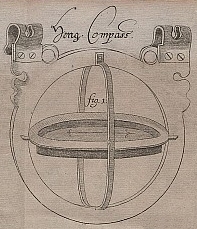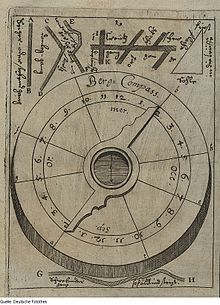Hanging compass
A hanging compass is a mining instrument that is used to determine the strike angle . Together with the straight line and the plumb line, it is part of the hanging equipment .
history
The forerunner of the hanging compass is the setting compass , which Georgius Agricola describes in the fifth book of his De Re Metallica Libri XII . The mountain master Balthasar Rösler invented the first hanging compass in 1633. This already had a cardanic suspension and its basic structure corresponded to the overhead compasses still used today. Later improvements were the locking device, a counterweight to correct the needle horizontal position and a more practical shape.
The old compasses had the traditional division of hours , that is, they were clockwise, starting with north and south, divided into 2 × 12 hours, where one hour was 15 °. The hours were initially divided into eighths, later the division into degrees prevailed. Balthasar Rösler provided his hanging compass with a left-hand graduation so that the strike angle can be read off directly. Even later, it was decided to continuously subdivide the full circle into 360 °, and in the 20th century the division of the full circle into 400 gons became generally accepted in marrow cutting and surveying .
construction
In contrast to normal compasses , the hanging compass is divided to the left, i.e. the division runs counterclockwise. Logically, the terms east and west are reversed compared to a normal compass. The reason for this arrangement is that the magnetic needle always assumes the same position, but the graduation is aligned according to the course of the measuring line.
The hanging compass consists of the compass sleeve in which the magnetic needle is rotatably mounted on a steel point. The compass graduation is marked on the bottom of the compass sleeve. On the underside of the sleeve is the locking device with which the magnetic needle can be lifted from the tip and pressed against the protective glass. The magnetic needle is marked on one side so that the north and south halves can be distinguished. The compass sleeve is connected to the ring by two bearings that are mounted axially in an east-west direction, so that the sleeve always swings horizontally. On the ring are the two brackets with the hanging hooks attached to the ends. The temples run in a north-south direction. In newer compasses, the ring and bracket are made from one part (Freiberg design). In the so-called Kassel design, the ring with two further bearings is hinged in the one-piece bracket in north-south direction, so that the compass can be folded flat to save space when not in use. This convenience comes at the price of a higher susceptibility, which can affect the accuracy.
use
While the hanging compass was the main and for the most part the only directional measuring instrument of the mark separator until Julius Weisbach introduced the art of visor markers , it has been pushed back in this use since the middle of the 19th century. This is due to the higher accuracy of a polygon measured with the theodolite , the increasing availability of the theodolites and the use of more and more steel and electric cables in the mines. Until the middle of the 20th century, side trains were measured with the hanging device, so in 1958 "Compass measurements ... in the Rhenish-Westphalian mining district were almost completely replaced by measurements with the hanging theodolite ...". Today the hanging compass is still used in caving because, if a simple accuracy is sufficient, it can be used more easily and even under adverse conditions.
Compass train
In order to be able to measure a strike angle with the hanging compass, the measuring points were first marketed with ridge nails along the mine construction to be measured . Beginning at a known marrow separator point, a cord was pulled taut between them .
Then the compass was hung on the string, the locking device was released and the strike angle was read off after the needle at the northern tip of the magnetic needle had swung into place. Then one exchanged the compass with the degree arc and read off the inclination of the line from this; Finally, the flat length between the two measuring points was determined with a laughing chain , measuring cord or measuring tape .
The angles and distances determined in this way correspond to the three basic elements of a polar image, as they are still used in modern geodesy. The sweep angle corresponds to the direction angle , the inclination to the vertical angle and the flat length of the inclined section . With these three measuring elements you can calculate a polygon, here called a compass .
accuracy
The reading accuracy of a hanging compass is 2 gon (with a division in 360 ° 1–2 °), half values can be estimated. To eliminate needle eccentricity, after the first reading, the compass is hung around 200 gon and read again; the arithmetic mean is formed from both readings.
To correct the magnetic deviation , it must be determined before the measurement. To do this, an orientation line is used, the angle of which is known and ideally runs exactly to astronomical north. The deviation determined in this way is applied to the read angle as an improvement. The determination of the needle deviation must be repeated regularly, at least once a year.
Since the compass is influenced by iron parts and current-carrying cables in its vicinity, care must be taken to ensure that there is sufficient distance when measuring. The equipment of the mark separator must also be free of iron. As a result, for example, there was an iron-free mine scraper model of every classic mining lamp type.
Final considerations
The hanging compass cannot be used in iron ore mines. Power lines and large masses of iron / steel in the pit are also a problem. Despite the lower measurement accuracy per se, compass trains have a decisive advantage: There can be no pivoting, since the stroke angle is measured on each side of the train regardless of the previous stroke angle.
Some geological compasses have string hooks and can be used as a hanging compass with less accuracy.
Compass moves are basically also possible with compasses that have a target device (mirror compasses, bearing compasses). A hanging compass is much more accurate.
literature
- Georg Agricola : De Re Metallica Libri XII . Twelve books on mining and metallurgy. Unchanged reprint of the first edition by VDI-Verlag, 1928 edition. Marixverlag, Wiesbaden 2006, ISBN 3-86539-097-8 , pp. 98-119 (Latin).
- Johann Friedrich Lempe : Thorough instructions for the art of marrowing . Siegfried Leberecht Grusius, Leipzig 1782, p. 81-106 .
- Otto Brathuhn: Catechism of Markscheidekunst . In: Weber's Illustrated Catechisms . tape 142 . Publishing bookstore by JJ Weber, Leipzig 1892, p. 86-99 .
- Ludger Mintrop : Mine sheath studies . Introduction to the, with special consideration of coal mining. 2nd improved edition. Springer-Verlag, Berlin 1916, p. 79-111 .
- Karl Neubert, Walther Stein: Plan and Risskunde . 1st lesson. Ed .: Main Department of Distance Learning at Bergakademie Freiberg. 1st edition. BG Teubner, Leipzig 1954, p. 1 / 09–1 / 12 .
- Alfons Schwieczek: Mine ventilation, surveying . In: The ore miner . A series of publications for vocational training in ore mining, especially in Mansfeld copper slate mining. Book II. Fachbuchverlag, Leipzig 1954, p. 44-46 .
- Gottfried Schulte, Wilhelm Löhr: Markscheidekunde . for mountain schools and for practical use. Ed .: Wilhelm Löhr, E. Wohlrab. 3rd revised edition. Springer-Verlag, Berlin / Göttingen / Heidelberg 1958, p. 224-244 .
- Hanging compass . In: Brockhaus Konversations-Lexikon 1894–1896, Volume 8, p. 786.
Web links
- Markscheider tools and their application ( Memento from February 12, 2009 in the Internet Archive )





